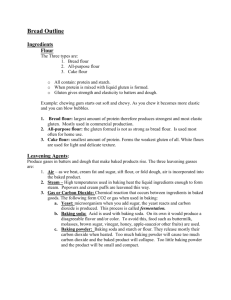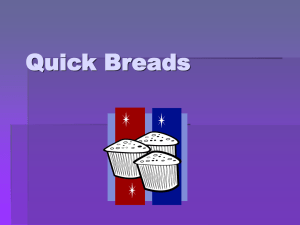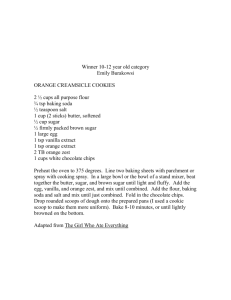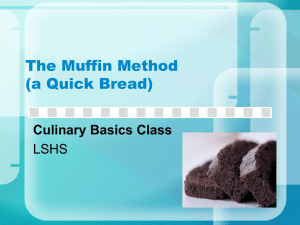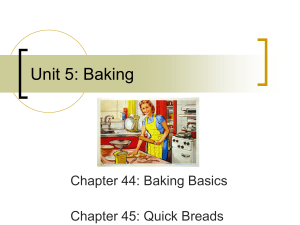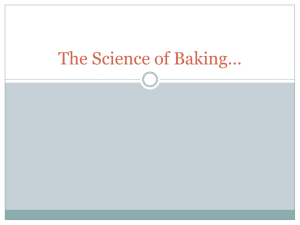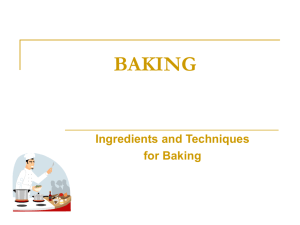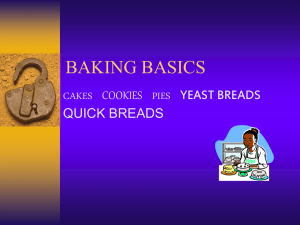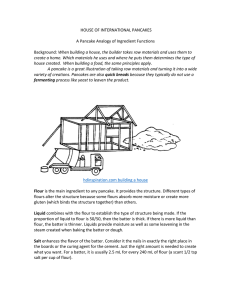Ch 44 Baked Goods and Ingredients
advertisement
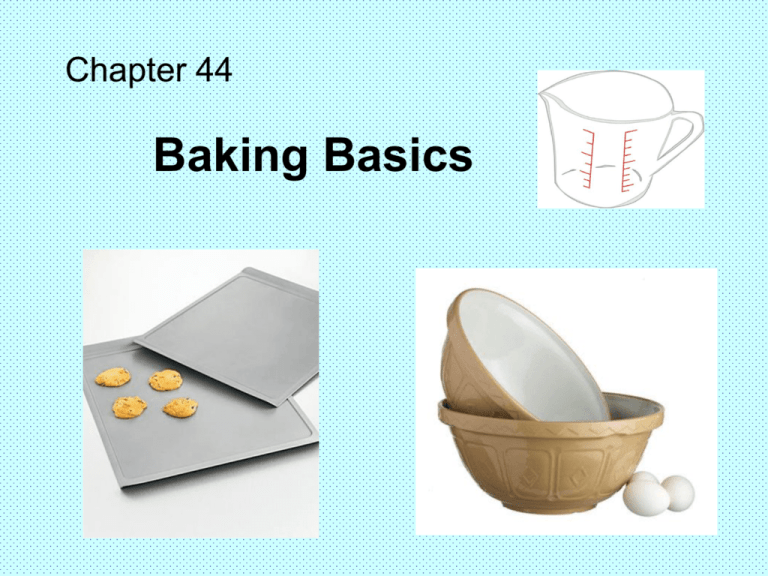
Chapter 44 Baking Basics Objectives • Describe basic baking ingredients • Explain the effects of different baking ingredients • Explain how to choose and store baking ingredients • Suggest ways to lower fat and sugar in recipes for baked goods • Describe and demonstrate basic techniques that are part of the baking process Key Terms • • • • • • • Active dry yeast Bleached flour Brown sugar Compressed yeast Confectioners’ sugar Gluten Granulated sugar • • • • • • • Hot spot Leavening agent Preheat Proofing Quick-rising yeast Self-rising flour Unbleached flour Functions of Sugar 1. 2. 3. 4. Adds flavor Aids in browning Tenderness and Moisture Increases volume incorporation of air into fat during creaming (mixture of fat & sugar) Types of Sugar and Storage • Granulated sugar • Confectioners’ sugar • Brown sugar – Store all sugars in a cool dry place. Keep brown sugar tightly sealed to avoid hardening. Leavening Agents Functions: Makes product light & porous 1. Yeast 2. Baking powder 3. Baking soda By the formation of gas, air, steam, and carbon dioxide. Types of flour & Protein Content • • • • • Whole wheat (hard) Bread (hard) All-purpose Pastry (soft) Cake (soft) • • • • • 14% 11% 10% 9% 8% Refined, Enriched, and Whole-Grain Breads • Germ:. • Endosperm:. • Bran:. • Refined and enriched are made from Endosperm only Function of Flour Gives structure to baked goods. Gluten - protein portion of flour with elastic characteristics necessary for the structure of most baked products. Gas becomes trapped in protein/gluten during baking and expands. The mixture stretches & volume increases. Starch – strengthens product through gelatinization Non-wheat flours • • • • • • Rice Rye Soy Buckwheat Triticale Potato Function of Fat in Baked Goods 1. Contributes to flavor & richness 2. Adds flakiness 3. Interferes with gluten development increasing tenderness of product 4. Increases volume 5. Type of fat determines flakey vs. tender Function of Liquids in Baked Goods Usually milk, water, or juice… - Hydrates protein/starch - Activates leavening agent - Disperses other ingredients - Contributes color and flavor Function of Eggs 1. 2. 3. 4. Contributes nutritive value Provides structure by means of coagulation Acts as an emulsifier Leavening agent (example: egg foams) Function of Salt • Provides flavor • Required in yeast breads Preparation of Quick Breads • The basic ingredients of any bread are: – Flour – Water or another liquid – Possibly salt – Leavening agent such as: baking soda or powder • Quick breads usually contain added fat, eggs, and sugar. Varieties of Quick Breads • • • • Pour Batters Drop Batters Soft Doughs Stiff Doughs Preparation of Quick Breads Muffin Method • • • • Sift dry ingredients together In a separate bowl, mix wet ingredients together. Blend wet & dry ONLY until moist (should be lumpy) ****Minimizes gluten development How can you tell when baked goods are done? Usually bake between 350 - 450 F • Volume becomes higher • Outsides become brown Testing & Removal • Color & time • Toothpick test – Remove immediately & cool on wire rack What happened to muffin B? Biscuit Method • • • • • • Sift dry ingredients Solid fat cut into dry ingredients Milk added and stirred Knead gently 8-10x Roll on a floured surface & cut Place on ungreased pan
